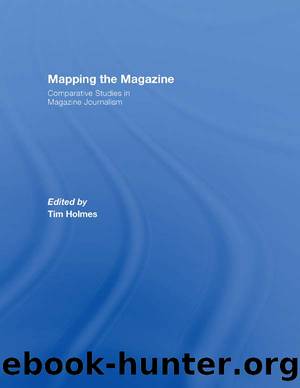Mapping the Magazine by Tim Holmes

Author:Tim Holmes [Holmes, Tim]
Language: eng
Format: epub
ISBN: 9780415494984
Barnesnoble:
Publisher: Taylor & Francis
Published: 2009-02-23T00:00:00+00:00
Conclusion
I want to return in conclusion to Johannesburg Lunch-hour, but this time a photographic essay by Peter Magubane published 12 years later in July 1963. Magubane did not recall being aware of the early photo-essay on this theme when he created his own.15 Two differences are immediately striking. First, this piece is confident enough to name the genre it belongs to; one can conclude therefore that the photographic essay has become an established and recognisable element of South African popular visual culture. Second, the photographer too is acknowledged as the creator of this piece; by this time Magubane along with a number of other black photographers had begun to establish a reputation in South Africa and were becoming known internationally. The photographic style and page design is more confident and sophisticated, but the themes remain the same, the everyday lives of South Africans as lived on the streets of Johannesburg:
It's 1pm and from a thousand offices and factories the people pour into the streets. DRUM photographer Peter Magubane spent one lunch hour touring the streets of Johannesburg to find out how people used their time.
Lunch-hour, to most people, means exactly what it says: a time to eat. And for the majority of these, it's usually an open-air lunch. The woman above, like the man on the left, takes her lunch standing up. But the veteran worker on the right likes to find a seat and a place to rest his back as he munches away at his mealie meal and sausage.
Magubane's essay is divided into four sections: eating, sleeping, playing, reading. Like the earlier essay, young men are shown playing a popular version of draughts (murabaraba16), although unlike the earlier essay one image here shows a white youth joining in a game of football.17 Although not shown, the text draws attention to the world of the shebeens: âthe lunchtime target of some of the city's intellectuals. Here they gather to argue over politics, art, literature, music⦠anything that makes lively conversationâ. Yet, like the early essay the context of the image also has a bearing on how it should be read. The romantic image of the shebeen as a hotbed of political and intellectual discussion (which in part Drum had helped to create) was rapidly fading into history. The Sharpeville massacre in March 1960 (images of which could not be published in Drum until October of that year) signalled a dramatic change in the political climate, and the operation of the press and photographers was significantly affected. By the time of the publication of this photographic essay, Nelson Mandela was already in prison, and it was in July 1963 in a raid on a farm in Rivonia that a number of Umkhonto we Sizwe (MK) members were arrested and various documents seized that would lead to the notorious Rivonia trial and life sentences for eight MK members, including Nelson Mandela, Walter Sisulu and Govan Mbeki. By April 1965 Drum had ceased publication as an independent monthly magazine, as Jim Bailey's papers suffered âincreasing government restrictions and interminable threatsâ (Woodson, 1988, p.
Download
This site does not store any files on its server. We only index and link to content provided by other sites. Please contact the content providers to delete copyright contents if any and email us, we'll remove relevant links or contents immediately.
Buying Reality: Political Ads, Money, and Local Television News by Danilo Yanich(410)
Handbook of Research on Deception, Fake News, and Misinformation Online by Chiluwa Innocent(181)
Mapping the Magazine by Tim Holmes(150)
Racism in American Popular Media: From Aunt Jemima to the Frito Bandito by Brian D. Behnken & Gregory D. Smithers(135)
Global Mobile Media by Gerard Goggin(131)
Media Literacy by W. James Potter;(130)
English for Diplomatic Purposes by Patricia Friedrich(124)
Transgression 2.0 by Ted Gournelos David J. Gunkel(116)
The Playful Citizen : Civic Engagement in a Mediatized Culture by René Glas; Sybille Lammes; Michiel de Lange; Joost Raessens; Imar de Vries(105)
Running the Family Firm: How the Monarchy Manages Its Image and Our Money by Laura Clancy(98)
Teaching to Transgress: Education as the Practice of Freedom by Hooks Bell(98)
Media and The City : Urbanism, Technology and Communication by Simone Tosoni; Matteo Tarantino; Chiara Giaccardi(95)
Powermatics by Marike Finlay - de Monchy(89)
The Digital Reporter's Notebook by Mark Blaine(89)
Hacking Gender and Technology in Journalism by Sara De Vuyst(87)
Transnational Television Remakes by Claire Perkins Constantine Verevis(86)
Mediating Post-Socialist Femininities by Nadia Kaneva(85)
Cultural Studies Vol 18 1 Jan 2 by Various Authors(83)
Persian in International Relations and Foreign Policy: A Content-Based Approach by Mohamad Esmaili-Sardari Daria Mizza(83)
